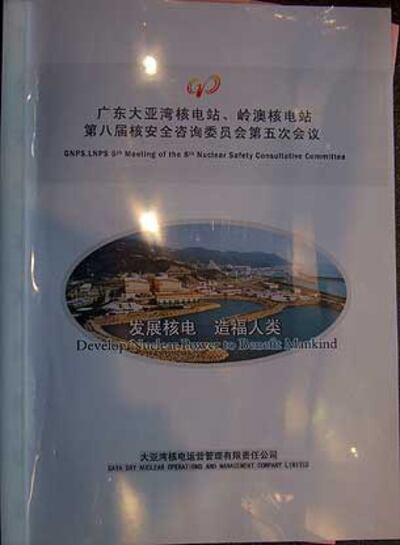HONG KONG—The Daya Bay nuclear power plant in southern China had a “very small leakage” from a fuel rod that has been contained, Hong Kong’s leading electricity supplier, CLP Holdings Ltd., said in a statement, but activists say the firm should have revealed the incident sooner.
A “small increase” in radioactive substances was detected in cooling water at the plant’s Unit 2 on May 23, CLP said in a statement. “The reactor cooling water is sealed in completely and isolated from the external environment, thus causing no impact to the public.”
Operations at the power plant were unaffected and a task force of nuclear experts had been formed to investigate the situation, CLP said.
Daya Bay Nuclear Power Station is located about 50 kms (30 miles) from the center of Hong Kong.
The Hong Kong Security Bureau also said a fuel rod at the Guangdong Daya Bay Nuclear Power Station experienced a “very small leakage” that increased radioactivity levels slightly in the nuclear reactor's cooling water on May 23.
The leak was "completely quarantined and, therefore, had no impact on the public," the bureau said.
Chairman of Hong Kong’s Safety Advisory Committee Raymond Ho Chung Tai said in an interview Tuesday that the danger to the public is negligible.
“This is only a minor incident. If we report such a minor incident, it will only trigger public panic,” he said.
But party opposition members and experts were not as dismissive.
Cover up?

Albert Lai, vice chairman of Hong Kong’s Civic Party, who has closely watched the development of the Daya Bay nuclear plant for more than a decade, urged the government and CLP to explain why the public was not informed about the incident until it was first reported by the media.
“[The members of the Hong Kong Safety Committee] should play a surveillance role and report to the Hong Kong government. If they are reporting their findings to the government, why didn’t the government report them to the public?” Lai questioned.
“This incident happened two weeks ago and obviously someone tried to cover it up.”
Members of the Hong Kong Democratic Party said they will pursue the matter with the government, while members of the pro-China Democratic Alliance for the Betterment and Progress of Hong Kong protested Tuesday in front of CLP headquarters on Hong Kong Island to express their anger over the cover-up.
Wan Sek Luen Laurie, managing director of Enviro-Chem Engineering Laboratory Co. Ltd, and member of the Daya Nuclear Power Station Nuclear Safety Advisory Committee, said CLP is misleading the public.
He said the statement the company issued that “the level of radioactivity has stabilized over the last two weeks since [the event], without material change” indicates that the fuel rod is still leaking.
“Neutrons cannot be totally sealed. It can go through walls and even the earth. It is the question of the degree of enrichment…Of course, some concrete walls can absorb radiation, but some of it is leaking [to the surrounding air] already,” Wan Sek Luen Laurie said.
“It can be said that some of the workers in the plant have been exposed to different levels of radiation. The fuel, when it makes contact with air, becomes uranium hydride, which can detonate in room temperature. It is very dangerous.”
Kok Wai Cheah, a professor at Hong Kong Baptist University said that though the fuel rod may only release a very small amount of radiation, the plant should follow international operating procedures by shutting down and replacing the rod.
“The crack [in the fuel rod] may be very small. But if the crack grows larger, the level of radiation will be higher. That means radiation within the reinforced concrete structure will also be higher. If anyone makes contact with it, their health will be in serious danger,” Kok Wai Cheah said.
Cheah warned that if the leaking radiation makes contact with the third external layer of concrete containment, it will endanger the lives of the public.
Citizens uninformed
Local citizens appear to be uninformed of the potential hazards to their health.
A resident in Ling Ao village near Daya Bay said people there know very little about the leakage.
“We can sometimes find information online. Otherwise, we know nothing about the incident,” the resident said.
The International Atomic Developmental Authority said in an e-mail that the International Atomic Energy Agency (IAEA) has seen media accounts reporting the detection of radioactivity in the cooling water at Daya Bay nuclear power plant’s Unit 2 reactor.
But the IAEA said it had received no official notification of the incident, nor did it expect to if the incident was as minor as news reports suggested.
The Daya Bay plant opened in 1994 to wide criticism because of its proximity to Hong Kong’s city center. More than 1 million people signed a petition opposing the plant during its construction.
Original reporting by RFA’s Cantonese service. Cantonese service director: Shiny Li. Translated by Shiny Li. Written for the Web in English by Sarah Jackson-Han and Joshua Lipes. Edited by Sarah Jackson-Han.
